Reuse and Recycle: How to Get the Most Out of Your Avid Armor Vacuum Sealer Bags
Posted by Avid Armor on Aug 2nd 2024
In today's world, sustainability isn't just a buzzword; it's a lifestyle choice. One of the simplest ways to embrace this mindset is by making the most of your kitchen tools, like your Avid Armor vacuum sealer bags. These handy bags are not only great for extending the shelf life of your food but can also be reused, reducing waste and saving money. However, it's essential to know when and how to reuse them safely. Let’s dive into the details!
When to Reuse Vacuum Sealer Bags
Before we get into the how-tos, it's crucial to understand when you can safely reuse your vacuum sealer bags. If you've used the bags for dry goods, fruits, vegetables, or other non-protein items, you’re in luck—they can be cleaned and reused multiple times. However, if the bags have stored proteins like meat, poultry, or fish, it’s best not to reuse them. Proteins can leave behind bacteria that might not be fully eliminated even after washing, leading to potential cross-contamination.


How to Properly Clean Your Vacuum Sealer Bags
To safely reuse your vacuum sealer bags, follow these simple steps for proper cleaning:
- Rinse Thoroughly: As soon as you empty the bag, rinse it out with hot water. This initial rinse helps remove any food particles or residue.
- Wash with Soap: Fill a sink or large bowl with warm, soapy water. Use a mild dish soap and wash the inside of the bag thoroughly. You can use a soft brush to scrub any stubborn spots gently.
- Sanitize: After washing, sanitize the bags by soaking them in a solution of one part vinegar to three parts water for about 10 minutes. Vinegar is a natural disinfectant and will help kill any lingering bacteria.
- Rinse Again: Rinse the bags thoroughly with hot water to remove any soap or vinegar residue.
- Dry Completely: Turn the bags inside out and hang them up to dry completely. You can use a dish rack or clothespins. Make sure the bags are entirely dry before storing them to prevent mold and mildew.
Resealing Partially Used Bags
One of the great features of Avid Armor vacuum sealer bags is their ability to be resealed. If you've only used a portion of the contents, you can easily reseal the bag for future use. Here's how:
- Cut and Clean: Cut the bag just above the seal, ensuring you leave enough room to reseal it. Clean the open edges with a damp cloth to ensure they are free from any food particles.
- Reseal: Place the open end of the bag into your vacuum sealer and follow the standard sealing process. Make sure the edges are aligned correctly to create an airtight seal.


Knowing When to Retire Your Vacuum Sealer Bags
While reusing vacuum sealer bags is a great way to reduce waste, it's important to recognize when a bag has reached the end of its lifespan. Reusing bags too many times can cause them to lose their integrity, potentially leading to poor seals and compromised food safety. Here are some signs that it’s time to retire your vacuum sealer bags:
- Visible Wear and Tear: Look for any signs of wear, such as thinning material, holes, or punctures. If the bag appears damaged, it’s best not to reuse it.
- Difficulty Sealing: If you notice that the bag is not sealing properly or maintaining a vacuum, it’s likely that the material has weakened.
- Odors and Stains: Persistent odors or stains that do not come out after washing are indicators that the bag is no longer safe to use.
- Multiple Uses: As a general rule, try not to reuse a bag more than two to three times, depending on its condition and what it has stored. Over time, repeated use and washing can degrade the bag’s integrity.
Tips for Extending the Life of Your Vacuum Sealer Bags
- Avoid Sharp Edges: When storing items with sharp edges, like bones or frozen foods, place a piece of paper towel or a cloth inside the bag to prevent punctures.
- Label and Date: Always label and date your bags. This practice helps you keep track of what’s inside and ensures you use older items first, reducing waste.
- Store Properly: Keep your cleaned and dried bags in a cool, dry place. Avoid folding them too tightly, as this can cause creases and weaken the material.

Reusing your Avid Armor vacuum sealer bags is a fantastic way to save money and reduce waste. By following these simple steps for proper cleaning, resealing, and knowing when to retire them, you can ensure that your food stays fresh while maintaining a safe and sustainable kitchen. Remember, while it’s tempting to reuse bags that have stored proteins, safety should always come first. Happy sealing and saving!

